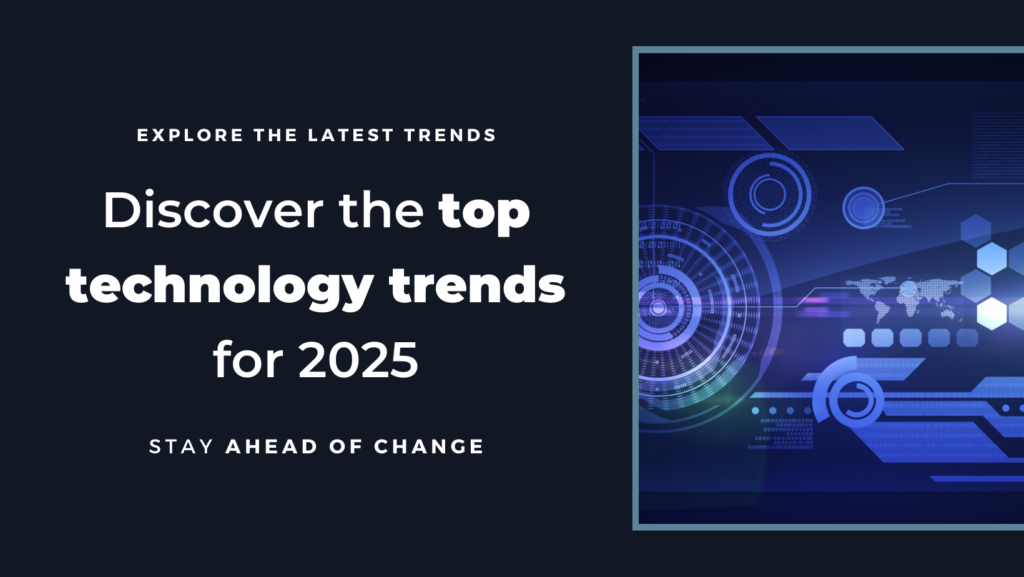Top 15 New Technology Trends for 2025

Technology is evolving at an unprecedented pace, transforming industries and shaping the way we live and work. From Artificial Intelligence (AI) to Quantum Computing, the year 2025 will see groundbreaking advancements that redefine the future.
In this blog, we’ll explore the top 15 technology trends for 2025, their impact, and how businesses and individuals can leverage them for success.
The Future of Technology: Staying Ahead in 2025
Technology is evolving unprecedentedly, driving rapid progress and transformation across industries. This acceleration is not just reshaping emerging technologies but also redefining the roles of IT professionals. In this contactless, AI-driven world, adaptability is no longer optional—it’s essential. By 2025, IT professionals will need to learn, unlearn, and relearn to stay relevant continuously.
What Does This Mean for You?
To future-proof your career, staying updated with emerging technologies and industry trends is crucial. The key to success lies in:
✅ Keeping an eye on the latest innovations shaping the digital landscape.
✅ Identifying in-demand skills to secure a competitive edge.
✅ Upskilling to adapt, thrive, and lead in the evolving job market.
Top 15 Technology Trends to Watch in 2025
To help you navigate the future, we’ve compiled the top 15 emerging technology trends that will drive transformation in 2025.
Your Path to Success in 2025
While technology continues to evolve, these 15 transformative trends will open exciting career opportunities for professionals across industries. Embracing change, mastering new skills, and staying ahead of the curve will be critical for success.
🌟 Take charge of your future—explore our expert-led programs and start upgrading your skills today!
1. Artificial Intelligence (AI) and Agentic AI
AI is no longer just about automation; it is evolving into Agentic AI, where AI systems can act independently, make decisions, and optimize processes. These AI models can self-learn, reason, and interact with humans more naturally.
💡 Key Developments:
- Self-learning AI models that require minimal human intervention.
- AI-powered virtual assistants capable of managing entire workflows.
- AI-driven predictive analytics for decision-making in finance, healthcare, and supply chain.
📌 Example: Imagine an AI assistant in corporate offices that schedules meetings, filters emails, drafts reports, and even makes strategic decisions based on company data insights.
2. Quantum Computing Advancements
Quantum computing is transitioning from research labs to real-world applications. Unlike classical computers, which process data in binary (0s and 1s), quantum computers use qubits, allowing them to process complex calculations exponentially faster.
💡 Key Developments:
- IBM, Google, and Intel are racing to achieve quantum supremacy.
- Quantum cryptography is making financial transactions unbreakable.
- Quantum AI will help in drug discovery and material science innovations.
📌 Example: JP Morgan Chase is using quantum computing to detect fraud patterns in real time, preventing financial cyberattacks.
3. The Rise of Spatial Computing
Spatial computing blends augmented reality (AR), virtual reality (VR), and mixed reality (MR) to create immersive digital experiences. This technology is set to revolutionize industries like retail, education, real estate, and healthcare.
💡 Key Developments:
- Apple Vision Pro, Meta’s AR Glasses, and Microsoft HoloLens leading the charge.
- AR-powered virtual shopping experiences with 3D try-on features.
- Surgeons performing remote surgeries using AR-assisted tools.
📌 Example: Imagine a real estate agent using AR glasses to show clients interactive 3D property walkthroughs without physically visiting the site.
4. Energy-Efficient Computing
As digital transformation accelerates, energy consumption in data centers is a growing concern. The shift towards energy-efficient computing focuses on sustainable solutions that reduce carbon footprints.
💡 Key Developments:
- Submerged data centers using ocean cooling to cut energy use.
- AI-driven power management systems optimizing energy consumption.
- Adoption of ARM-based processors, which consume less power than traditional chips.
📌 Example: Microsoft’s Project Natick is testing underwater data centers that rely on natural cooling, reducing electricity costs and carbon emissions.
5. 6G Networks and Ultra-Fast Connectivity
5G is still expanding, but 6G is already in development. With speeds expected to be 100 times faster than 5G, 6G will enable real-time communication, ultra-low latency, and hyper-connected smart cities.
💡 Key Developments:
- AI-driven network optimization for seamless connectivity.
- Holographic communication for business meetings.
- IoT-powered fully automated smart cities.
📌 Example: A 6G-enabled smart city will feature self-driving cars, AI-controlled traffic signals, and real-time emergency response systems.
6. Decentralized Finance (DeFi) and Web3 Expansion
The traditional banking system is being disrupted by DeFi (Decentralized Finance) and Web3, powered by blockchain. DeFi eliminates intermediaries, offering faster, transparent, and cost-effective financial transactions.
💡 Key Developments:
- Smart contracts automating loan approvals and insurance claims.
- Blockchain-powered cross-border transactions with minimal fees.
- Web3-based decentralized social media platforms.
📌 Example: A DeFi-based lending platform allows users to borrow money instantly without needing a bank, using cryptocurrency as collateral.
7. Ambient Computing and Invisible Technology
Ambient computing creates a world where devices work seamlessly in the background, responding to human needs without manual input.
💡 Key Developments:
- AI-powered home automation systems.
- Smart sensors embedded in furniture, appliances, and clothing.
- Wearable AI devices providing real-time health monitoring.
📌 Example: Amazon’s Alexa and Google Nest use ambient computing to adjust lighting, temperature, and security based on user behavior.
8. Generative AI and Content Creation
Generative AI is revolutionizing marketing, entertainment, and content creation, producing text, images, videos, and even music.
💡 Key Developments:
- AI-generated movies, advertisements, and social media content.
- Personalized AI storytelling for gaming and interactive media.
- AI-powered code generation for software developers.
📌 Example: ChatGPT, MidJourney, and RunwayML are enabling marketers to create ad copy, visuals, and videos within minutes.
9. Brain-Computer Interfaces (BCI)
BCI technology allows direct communication between the brain and digital devices, offering life-changing applications in healthcare and gaming.
💡 Key Developments:
- Neural implants helping paralyzed patients regain mobility.
- Mind-controlled video games and robotic prosthetics.
- AI-powered memory enhancement devices.
📌 Example: Neuralink’s brain implant allows disabled individuals to control computers and wheelchairs using just their thoughts.
10. Edge AI and Distributed Computing
Edge AI brings AI processing closer to the source of data (e.g., IoT devices) instead of relying on cloud computing.
💡 Key Developments:
- AI-powered real-time analytics for security and automation.
- Autonomous drones making split-second decisions.
- AI-driven predictive maintenance in manufacturing.
📌 Example: Self-driving cars use Edge AI to process sensor data in real-time, ensuring safety without depending on cloud servers.
11. Advanced Robotics & Automation
Robots are becoming more intelligent, autonomous, and versatile, making them integral to industries like manufacturing, logistics, healthcare, and agriculture.
💡 Key Developments:
- AI-powered warehouse robots optimizing supply chain logistics.
- Autonomous farming machines handling planting, harvesting, and irrigation.
- Surgical robots enhancing precision in complex medical procedures.
- AI-driven humanoid robots assisting in customer service and elderly care.
📌 Example: Boston Dynamics’ robot “Stretch” is designed to move boxes in warehouses, increasing efficiency and reducing human labor costs. Similarly, Tesla’s Optimus humanoid robot is being developed for general-purpose tasks in homes and industries.
12. Cybersecurity Innovations
As digital transformation accelerates, cyber threats are becoming more sophisticated. AI-powered cybersecurity solutions and zero-trust security frameworks are crucial for protecting businesses, governments, and individuals.
💡 Key Developments:
- AI-driven threat detection to prevent cyberattacks before they happen.
- Blockchain-based security for decentralized identity verification.
- Quantum cryptography ensuring unbreakable data encryption.
- Automated Security Operations Centers (SOCs) monitoring cyber threats in real time.
📌 Example: Companies like Darktrace and CrowdStrike use AI-driven cybersecurity tools to detect and neutralize cyber threats before they cause damage. Additionally, banks are leveraging behavioral biometrics to prevent fraud by detecting suspicious activities in real-time.
13. Biotech & Personalized Medicine
Biotechnology and AI-driven personalized medicine are revolutionizing healthcare by tailoring treatments based on an individual’s genetic makeup, lifestyle, and medical history.
💡 Key Developments:
- AI-powered drug discovery reducing the time needed to develop new medicines.
- CRISPR gene editing enabling precise treatment for genetic disorders.
- Wearable health devices continuously monitoring patient vitals.
- AI-assisted diagnostics providing early disease detection through medical imaging.
📌 Example: DeepMind’s AlphaFold AI has cracked the protein-folding problem, helping researchers develop cancer drugs and vaccines faster. Meanwhile, companies like 23andMe offer genetic testing services that help predict disease risks and recommend personalized treatments.
14. Smart Factories & Industrial IoT (IIoT)
Smart factories leverage Industrial IoT (IIoT), AI, and robotics to optimize production, reduce waste, and enhance efficiency. These factories operate with minimal human intervention, increasing productivity and safety.
💡 Key Developments:
- Predictive maintenance using IoT sensors to prevent machinery failures.
- AI-powered automation streamlining production lines.
- Digital twins creating virtual replicas of factories to simulate operations.
- 5G-powered smart warehouses enabling real-time inventory tracking.
📌 Example: Siemens and General Electric (GE) use digital twins to create virtual models of their factories, allowing engineers to test and optimize processes before implementing changes in the real world. Tesla’s Gigafactories also use AI-driven automation to speed up electric vehicle production while minimizing energy consumption.
15. Ethical AI & AI Regulations
With the rapid rise of AI, ethical concerns such as bias, data privacy, and transparency are being heavily scrutinized. Governments and organizations are implementing stricter regulations to ensure responsible AI development and deployment.
💡 Key Developments:
- AI transparency laws requiring companies to disclose how AI makes decisions.
- Bias detection algorithms ensuring fair and unbiased AI models.
- Explainable AI (XAI) making AI decision-making more understandable.
- AI governance frameworks defining ethical AI usage across industries.
📌 Example: The European Union’s AI Act is setting global standards for ethical AI by regulating high-risk AI applications, such as facial recognition and AI-powered decision-making in hiring and healthcare. Similarly, Google and OpenAI are investing in AI safety research to prevent AI misuse.
Final Thoughts
These 15 emerging technology trends are set to reshape industries, enhance human capabilities, and drive innovation in 2025. Whether it’s autonomous robots, quantum computing, or ethical AI, businesses and individuals must adapt to stay ahead in this fast-changing digital landscape.
💡 Which technology do you think will have the biggest impact in 2025? Let us know in the comments!
At Ignisys IT, we understand that staying ahead in today’s fast-paced tech world requires continuous learning and upskilling. Our top-notch training programs are designed to equip you with in-demand skills that will help you thrive in the evolving job market.

Leave a Reply